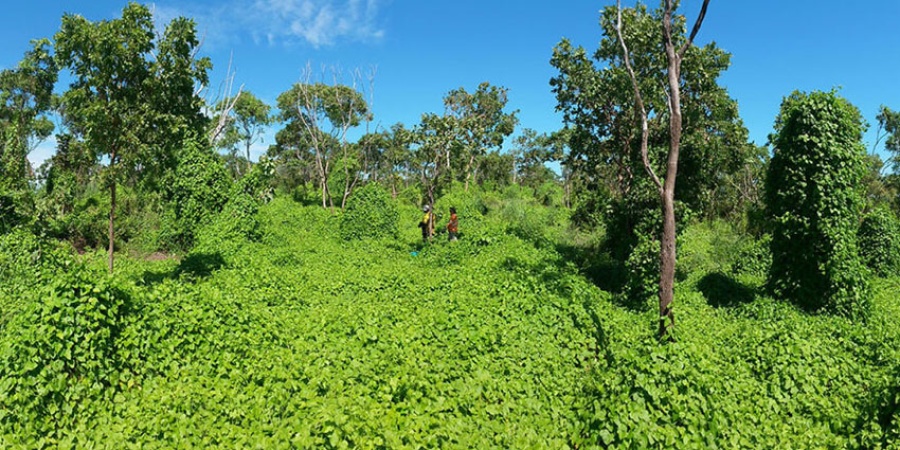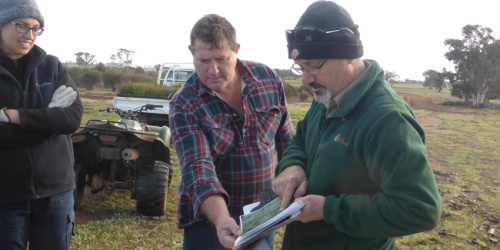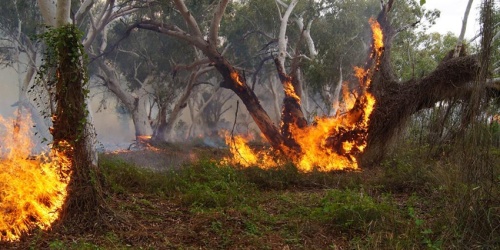
Stinking passionflower (Passiflora foetida). Photo by Bruce Webber/CSIRO
Prioritisation process for weed management
Parks and Wildlife Service’s species-led prioritisation process assesses weeds in each region based on:
- ecological impact
- invasiveness
- current distribution
- potential distribution
- feasibility of control
The resulting priorities focus on weeds considered to be high impact, rapidly invasive and still at a population size that can feasibly be eradicated or contained to a manageable size.
This means that weed species which are already widespread are not ranked as a high priority through this species-led process.
The next stage of the process identifies high value biodiversity assets, the weeds that pose a threat to these assets, and the sites where control will have the greatest benefit and cost effectiveness. Social, cultural and economic assets as well as good neighbour issues are considered at a later stage of the process.
See Weed Prioritisation Process(135KB PDF) for further details on the context and methodology of the process, including how each weed was scored.
Summaries of the species ecological impact and invasiveness rankings are provided here to help other landholders, community groups and private enterprises manage weeds that might impact on the natural environment.
Ranking summary results by Parks and Wildlife Service region
Species-led ecological impact and invasiveness ranking summary results by region. The following Excel documents can be sorted by columns to find the information you require.
- Goldfields Impact and Invasiveness Ratings (Available in the Downloads section below)
- Kimberley Impact and Invasiveness Ratings (Available in the Downloads section below)
- Midwest Impact and Invasiveness Ratings (Available in the Downloads section below)
- Pilbara Impact and Invasiveness Ratings (Available in the Downloads section below)
- South Coast Impact and Invasiveness Ratings (Available in the Downloads section below)
- South West Impact and Invasiveness Ratings (Available in the Downloads section below)
- Swan Impact and Invasiveness Ratings (Available in the Downloads section below)
- Warren Impact and Invasiveness Ratings (Available in the Downloads section below)
- Wheatbelt Impact and Invasiveness Ratings (Available in the Downloads section below)
Notes on using the ranking summaries
Some species that are native to specific regions of Western Australia occur on these prioritisation lists as they have shown 'weedy' tendencies outside their natural range, such as on islands in the Pilbara region.
The prioritisation for individual weeds within a Parks and Wildlife Service region should be treated as a guide and does not diminish any other requirements of land managers or developers, such as declared plants requirements of the Biosecurity and Agriculture Management Act 2007 or Ministerial requirements under Part IV of the Environmental Protection Act 1986.
Looking for information? contact us at weeds@dbca.wa.gov.au.
In Western Australia, the presence of weeds presents a significant challenge for the preservation of vulnerable flora and ecosystems.
This challenge is particularly noticeable for critically endangered plants, which are highly susceptible to the encroachment of invasive weeds.
These non-native plants can outcompete indigenous species, leading to at-risk species being restricted to small, disrupted areas. In some cases, they can contribute to their decline.
This situation emphasises the importance of a well-planned and collaborative approach to weed management in Western Australia. This will safeguard the long-term sustainability of native species and ecological communities.
The impact of weeds on WA's biodiversity
The presence of weeds can threaten natural ecosystems and the native species they support.
Weeds may lead to biodiversity loss by competing with native species and modifying and disrupting ecosystem processes.
They do this by:
- outcompeting native species for resources, including available nutrients, water, space and sunlight
- replacing the native plants that animals use for shelter, food and nesting
- impacting on native plants or animals due to toxins they release or contain, or excluding animals from their habitats because of thorns or other harmful characteristics
- providing habitat for introduced animal pests
- altering fire regimes, potentially making fires more intense, and possibly altering their seasonality and frequency
For example, Passiflora foetida is a dynamic and aggressive vine that poses a significant threat to the biodiversity of WA’s Pilbara and Kimberley regions. The vine suffocates native vegetation, leading to the death of trees and reducing vertebrate habitats such as nesting hollows. Passiflora foetida also increases fuel loads, which increases the risk and severity of canopy fires in forest habitats. The vine is also impacting available nesting space for freshwater crocodiles on Lake Argyle, compounding the already limited availability of suitable areas.
Managing WA's weed problem
In Western Australia, the number of weed species present is a significant challenge to strategic and effective weed management.
There are more than 1300 weeds currently listed in WA. DBCA employs robust prioritisation strategies and management techniques to tackle the issue.
While the threat of invasive weeds is a concern for both biodiversity and agriculture, the approach to managing them can vary. This means the classification of different weed species can differ between legislation and strategies.
For example, the Biosecurity and Agriculture Management Act 2007 (BAM Act) provides a legal framework to regulate and manage the introduction and impact of environmental and agricultural weeds across WA. While the BAM Act provides a process for declaring species that pose a significant risk, not all declared species pose such a risk to the environment. Many environmental weeds that are not declared have a severe impact on natural ecosystems. Therefore, while DBCA considers the legal status of weed species, it does not solely rely on this to determine control priorities for the natural ecosystems the department manages.
Instead, DBCA assesses weed species in each region based on their ecological impact, current and potential distribution, invasiveness, and the feasibility of controlling them. This species-led prioritisation process helps identify the weeds considered high impact, rapidly invasive and still at a population size that can feasibly be eradicated or contained to a manageable size.
This approach means weed species that are already widespread may not be ranked as a high priority. Instead, controlling widespread weeds is prioritised by identifying areas where high-value biodiversity assets may be impacted, which weeds pose the greatest threat to these significant habitats or species, and the sites where control will have the most significant biodiversity benefit and cost-effectiveness. Social, cultural, and economic assets, as well as good-neighbour relations, are also considered.
Want to know more about our methodology behind the process, including how each weed is scored to assist you in prioritising the weeds you manage? Download the Weed Prioritisation Process.
Weed impact and invasiveness ratings
Summaries of weed species' ecological impact and invasiveness rankings are provided here to help landholders, community groups, and private enterprises manage weeds that might impact the natural environment. These Excel documents can be sorted by columns to find the information you require. When downloaded, additional columns can be added to include your own feasibility of control and current and potential distribution. Refer to the Weed Prioritisation Process document above to see how you can use this process to determine your priority weed species.
Some species native to specific regions of Western Australia occur on these prioritisation lists as they have shown 'weedy' tendencies outside their natural range, such as on islands in the Pilbara Region.
The prioritisation for individual weeds within a particular region should be treated as a guide and does not diminish any other requirements of land managers or developers, such as management of declared plants obligations under the Biosecurity and Agriculture Management Act 2007 (BAM Act) or Ministerial requirements under Part IV of the Environmental Protection Act 1986.
Legislation that underpins weed management in WA
Policies and strategies at national and state levels underpin weed management in WA.
| Australian Weeds Strategy | Biosecurity and Agriculture Management Act 2007 | WA Organism List | DBCA Corporate Policy Statement 14: Weeds Management |
| National strategy to provide governments, landholders, industry and the community with a clear set of best practice guidelines to facilitate coordination among stakeholders to guide effective weed planning and management efforts. | The Biosecurity and Agriculture Management Act 2007 (BAM Act) provides a legal framework for regulating and managing the introduction and impact of environmental and agricultural weeds in WA. This Act enables the WA Government to declare certain plants as either prohibited or declared pests to regulate the control, movement, sale and cultivation of species that pose a significant risk. | Search for an organism's declaration status under the Biosecurity and Agriculture Management Act 2007. | This policy provides direction and guidance for managing weeds on lands managed by DBCA. |
| Australian Weeds Strategy 2017-2027 | Biosecurity and Agriculture Management Act 2007 | Western Australian Organism List | DBCA corporate policies |
Research
Research can lead to a better understanding of the ecology, biology, and life cycle of weeds. This can help inform the identification of the most effective, efficient and innovative control methods. This includes the use of environmentally appropriate herbicides, mechanical treatments, rehabilitation of degraded habitats by encouraging regeneration of native species and biological control.
Research can also assist in quantifying the effectiveness of weed control programs, identifying ecosystems and habitats potentially vulnerable to the invasion of weed species and identifying the potential long-term impacts of weeds on native species and ecosystems, which can help in weed management prioritisation.
For example, limited knowledge of the biology and ecology of Passiflora foetida may impede the identification of more effective and efficient weed management strategies, including biological control. Current control methods include hand-pulling and herbicide application, which can be costly and labour-intensive, with limited long-term benefit.
DBCA is currently undertaking research to better understand the provenance of weedy populations of P. foetida to identify potentially suitable biological control agents.
Limited understanding of the effectiveness of specific herbicides, land management actions, and their combination in controlling weed impacts constrains the department’s ability to effectively manage weeds at landscape scales. To address this knowledge gap, DBCA is testing the efficacy of new herbicides and combined herbicide and land management approaches, including prescribed fire, to control grassy weeds in the Swan and Kimberley regions.
Resources
The impact of weed species can extend over vast areas, crossing various local, state, and territory boundaries.
Sharing best practices can guide other affected stakeholders, including local governments, regional natural resource management groups, industry, landowners, and the broader community. Collective efforts can maximise weed management outcomes.

